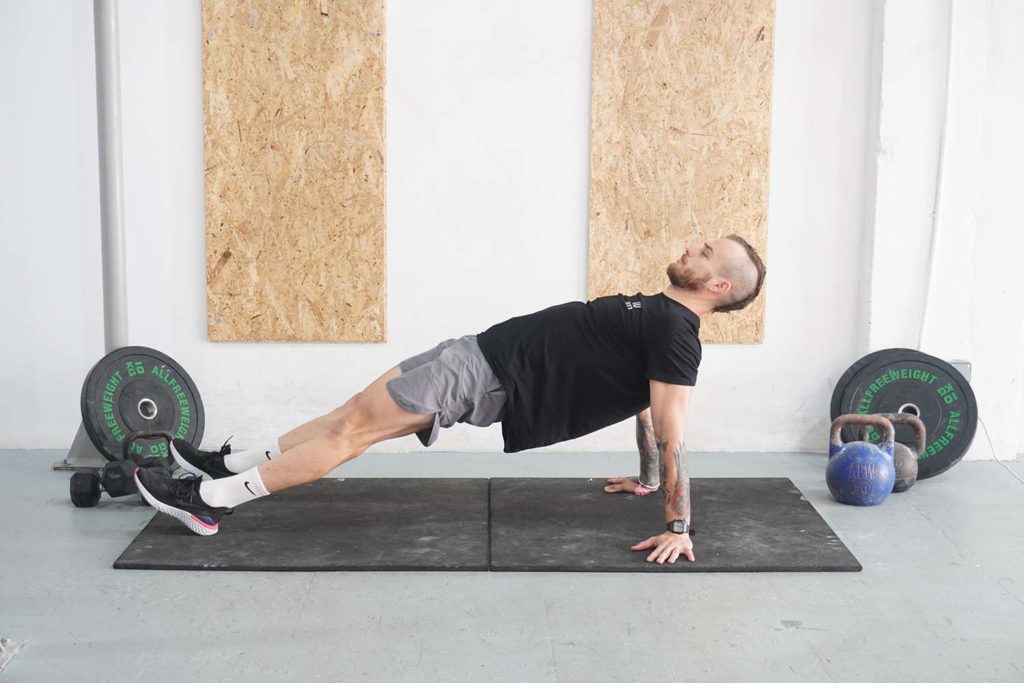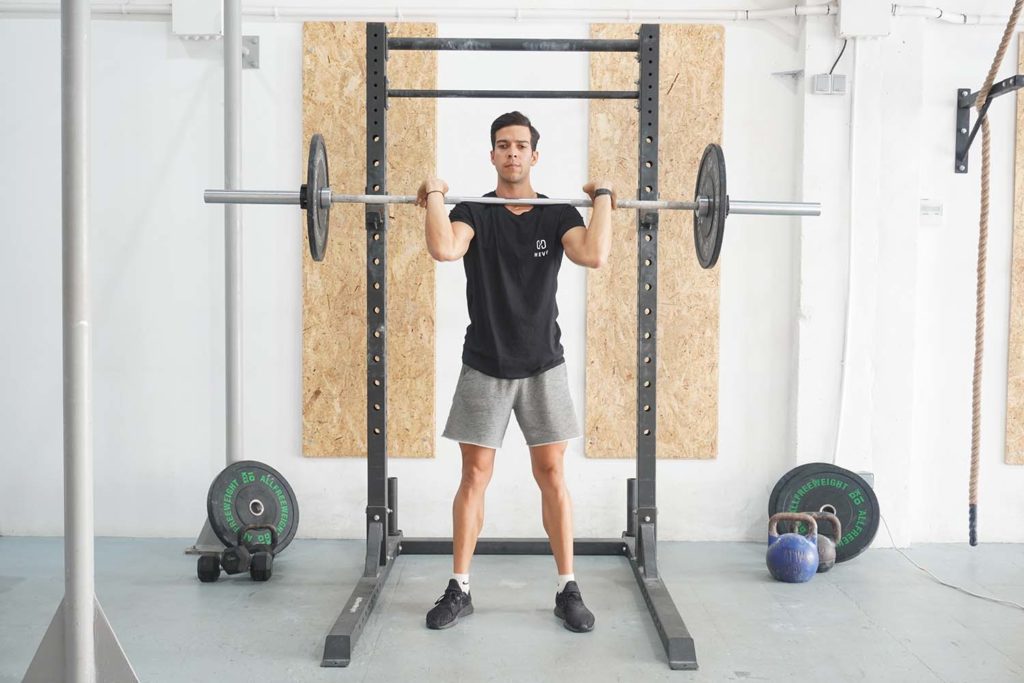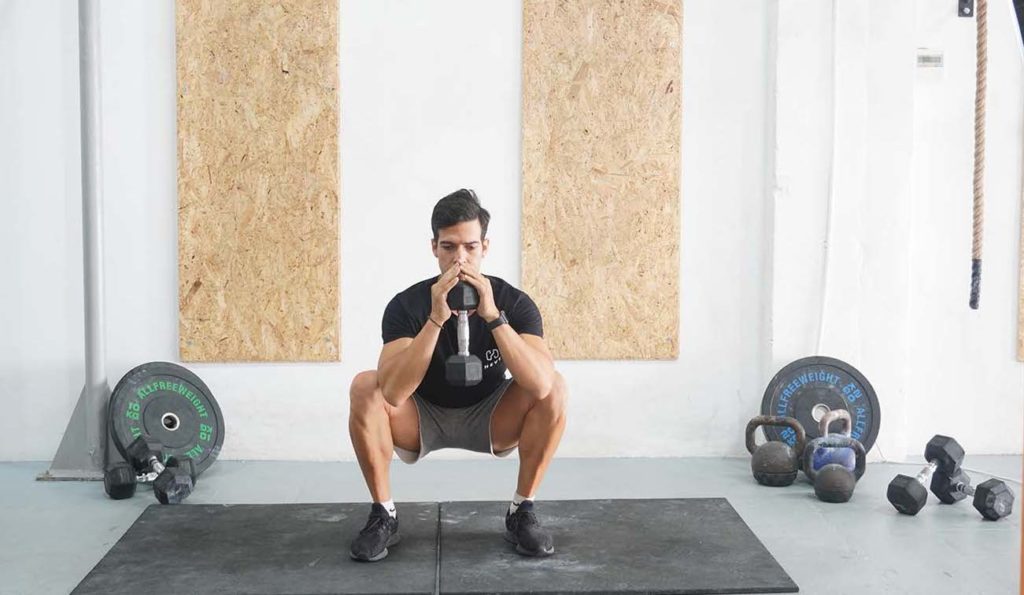Benefits of the Wall Sit
The wall sit is a simple and beginner-friendly movement that strengthens your quadriceps and midsection (1). The objective is to place your back and buttocks against a wall, descend into a squat and hold the position. Doing so builds isometric strength and improves your balance.
A huge benefit of wall sits is that the movement allows you to train a range of major muscle groups in the body without placing stress on your joints. For example, the wall sit strengthens your quadriceps without putting pressure on your knees. But despite the simplicity, the movement builds whole-body strength that improves athletic performance and makes everyday tasks more accessible.
You can include wall sits in the middle of your workouts or toward the end. Begin with two to three rounds of 20 to 30 seconds and build up from there.
How to do a Wall Sit
- Position your upper back flat against a wall. Your head, upper back, and butt should be in contact.
- Extend your legs forward several inches, position your feet at hip-width distance, and plant them firmly on the floor.
- Engage your core and slide down the wall while keeping your back in contact with it.
- Lower yourself until your knees are at a 90-degree angle, and your thighs are parallel to the floor. Your knees should be straight up from your ankles and in line with your hips. Your upper and lower back should remain in contact with the wall.
- Extend your arms forward for balance if you wish.
- Keep your midsection and glutes engaged throughout this movement, and make sure to take deep breaths.
- Once you’re finished, slide up the wall by engaging your lower body and pushing through your heels, much like you would on a squat.
What muscles does the wall sit activate?
The primary muscles that work during a wall sit are our quadriceps, the large four-headed muscles covering our thighs’ front side and producing knee extension (2). The muscle group works hard to keep our knees at a 90-degree angle during a wall sit (1). Our hamstrings, glutes, and calves work during a wall sit to assist the quadriceps.
_Thighs_small.jpg)
Midsection muscles (rectus abdominis, transverse abdominis, and obliques) also work during wall sits to support the torso and keep us stable. Similarly, wall sits work some back muscles, including our erector spinae, rhomboids, and trapezius, which keep our shoulder blades retracted and torso rigid.
Tips on doing a Wall Sit with Proper Form
One of the most important things you need to do is ensure that your back and buttocks are against a wall. Doing so will allow you to assume the correct position and avoid unnecessary stress on your back.
As you descend, ensure that your thighs are parallel to the floor or close to the position. It might not seem important, but reaching adequate depth will allow you to engage your quadriceps better. Similarly, you should ensure that your shins remain in a vertical position. Meaning, your knees should be directly over your ankles, and your weight should be distributed evenly on your feet.
It’s also essential to keep your chest out and your upper back flat against the wall as you do the exercise. Slouching forward puts unnecessary stress on your back and can contribute to poor posture. Engage your upper back before a wall sit and maintain that position until you’re finished.
Variations and Modifications of the Wall Sit
1. Quarter Wall Sit
The quarter wall sit is a simple beginner-friendly variation that allows newbies to learn the exercise. Instead of descending until your thighs are parallel to the floor, walk your feet out slightly until you feel some pressure in your quadriceps. Gradually increase the depth over a few weeks as you build strength and muscle endurance.
2. Loaded Wall Sit
In contrast to quarter wall sits, the loaded variation works well for more advanced trainees to challenge themselves further. For example, you can descend into a wall sit, and place a weight plate on your thighs for extra resistance.
3. Single-Leg Wall Sit
Single-leg wall sits are an effective variation that challenges you even more. The goal is to descend into a wall sit, lift one foot off the floor and straighten it. Aside from forcing the supporting leg to work extra hard, the position allows you to engage your abs more effectively.
Mistakes to Avoid
A common mistake with wall sits is not achieving adequate depth. Many trainees descend but not enough, making the exercise less effective than it can be. As you drop, ensure that your thighs are parallel with the floor and that you feel adequate tension in your quadriceps.
Another common mistake with wall sits is having your knees travel in front of your toes. Doing so places more stress on your knees and forces you to support more of your weight on your toes, making the wall sit unnecessarily difficult. Instead, you should have your shins in a vertical position with knees directly over your ankles.
Slouching forward is the third significant mistake to avoid when doing wall sits. Often, trainees start with an erect torso but slouch forward due to fatigue. A good wall sit means the correct leg and torso position. Do the movement for as long as you can, and take a break if you notice that your posture is getting worse.
Similar Exercises to the Wall Sit
Reverse Plank

The reverse plank is an isometric exercise that strengthens your quadriceps, glutes, and midsection like the wall sit. The objective is to extend your body in a reverse plank position with your torso facing the ceiling and arms supporting your upper body.
Front Squat

Front squats are an effective compound exercise that strengthens your quadriceps and builds up your upper back. Unlike back squats, the goal with the movement is to place the barbell in a front rack position, forcing a more upright torso. As a result, your hips extend to a much smaller degree, and your quadriceps do most of the work (3).
Goblet Squat

Similar to front squats, the goblet squat is an effective quad-strengthening exercise. Your objective with the movement is to hold a dumbbell in front of your chest as you squat. In doing so, you engage your upper back and midsection muscles much more effectively.
